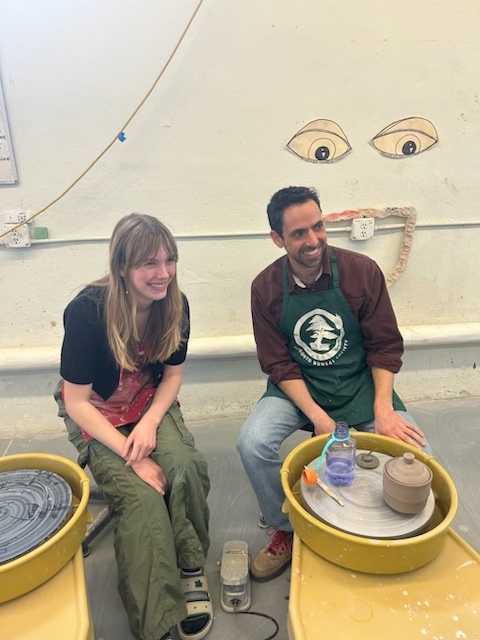Centering Yourself: Audrey Raupp ’25 in Conversation with Ceramics Professor Judd Schiffman
If you’re ever in need of a safe haven on the PC campus, follow this path: start walking downhill, past any building bustling with student life, and keep going until you reach the fence that marks our lower campus boundary. Take a sharp right at the fence and walk until you’re facing a large red door (if you enter the construction area, I’m afraid you’ve gone too far). Most students don’t frequent this part of campus, but it takes you right to the Ceramics Building. As an art minor concentrating in ceramics, I spend a lot of time here engaging with my medium of choice (clay!), working on homework for other classes, and spending time with peers who also study ceramics. We are all united by the dual serenity and energy working with clay affords us.
My peers and I were particularly excited to learn that our professor, art department faculty member, and ceramicist Judd Schiffman, has been awarded a Riccobono Academic Resilience Faculty Fellowship for his wheel throwing class. The grant was created by PC alumnus and UNTUCKit founder Chris Riccobono (’01), and his wife, Amy Parillo (‘03), to encourage professors’ inclusion of student mental health discussions and wellness activities in their curriculum. Riccobono struggled with mental health issues as an emerging adult entering the workforce and wanted to recognize the overwhelming stress and demands placed on college students. Professors from multiple departments and disciplines, from science and business to theology and education, have utilized the grant since its creation in 2019. And now, Judd is a member of this revolutionary group.
On a personal level, I was excited to learn about the Riccobono grant as both a psychology and visual art student. The intersection of the arts and mental health/wellness is a fundamental aspect of my future studies. I’d like to pursue a career in pediatric art therapy, as I believe art can function as an interface for facilitating psychological healing and well-being. It emphasizes creativity, self-expression, and self-reflection, all of which are important as children develop skills in empathy, perspective-taking, emotional recognition and regulation, and peer socialization. The physical act of making a piece is soothing, but so is the way we give it meaning through function, design, reflection, and meaningful conversation with the people around us. I feel heard and seen when I can make and talk about my art, and I’d like to extend this opportunity to children who could benefit in the ways I have.
Before my first throwing class, I spoke with Judd (he likes us to call him by his first name) about his perspective on wellness and the Riccobono grant. I asked how our curriculum would put the creation of ceramics in conversation with the practice of wellness; the Riccobono grant, Judd explained, has helped him formalize the practice of meditation, which he always includes in the throwing classes. For about five to ten minutes after the class settles at our wheels, Judd leads a group meditation focused on breathing and clearing the mind. “The practice of meditation to me is very similar to the practice of wheel throwing,” Judd says. The clay must be correctly centered on the wheel before you start to shape your piece, or else the fledgling pot will quickly become lopsided and unsteady. However, the mind must also be centered to correctly center the clay. Focusing too hard on other thoughts when you throw makes the experience significantly more difficult, and you’ll spend too much time with one lump. Thus, distancing yourself from the complexity of life, albeit for a few minutes at a time, and focusing exclusively on the clay and wheel is integral to a successful practice. However, Judd describes the class as not being “results-oriented”; we want to achieve growth over the semester rather than making the perfect piece.
And while our meditation times may be silent and reflective, we students in the class spend the rest of our time talking and bonding while we throw. I can see friendships blossoming and growing stronger each time I sit down at the wheel. We joke, laugh, support each other, and shine a light on what makes each of us a unique individual in the studio space. In all, the class has each other’s backs, and
throwing would not be as enjoyable if we were not together. This falls in line with Judd’s goal for us as students and humans in this class: “I hope students take away a love and joy of being in the studio and end up making things together. It is a community-oriented class; we become friends. I hope we create a supportive learning environment where we support each other in our ceramics practice and the practice of meditation.”
While we all still have a lot to learn regarding technique and process, I can say with surety that all students have improved since we first sat at the wheel. Judd is an excellent professor to explore this medium with, as his consistently empathic demeanor makes his students feel comfortable and appreciated in the studio. He challenges us to make innovative works and push through boundaries, especially those that we set for ourselves. And most importantly, Judd challenges us to look inward, and try to discover an internal balance that will help us inform our work and how we go about our lives.






